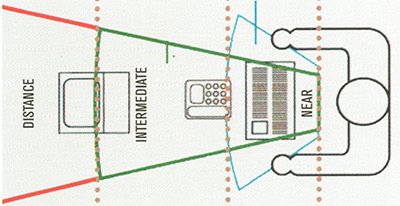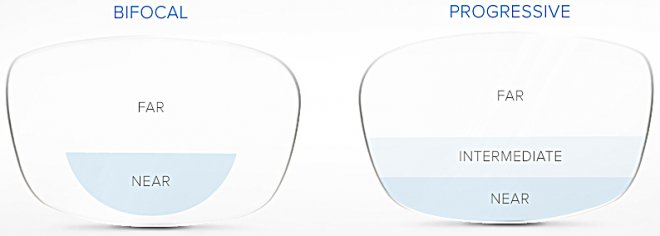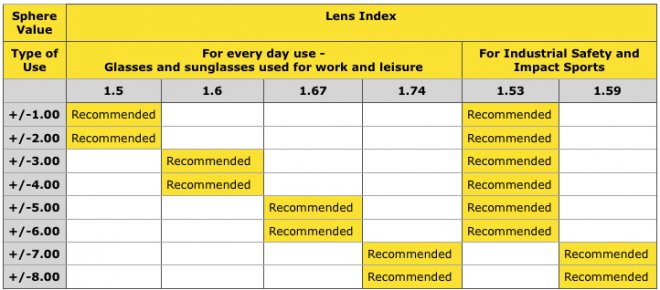
Useful Information when Choosing Varifocal Prescriptions Online
Useful Information when Choosing Varifocal Prescriptions Online
Frequently Asked Questions when choosing Varifocal (Progressive) Prescriptions
What are Varifocal Lenses?

Varifocal lenses also known as progressive lenses consist of 3 viewing zones:
Distance zones - the upper area of the lens designed to provide clear distance vision.
Intermediate (Middle) zone - this area allows your eyes to smoothly transition between distance to near vision.
Near zone - the lower area of the lens provides sharp vision close up e.g. reading.

Unlike bifocals, varifocal lenses do not contain a distinct reading segment, usually called a D segment that has a visible dividing line between the distance vision and reading. Bifocals offer a distinct reading segment up to about a third of the lens height from the base. Varifocal lenses gradually change in strength from the top the lens to the bottom.
During transition between the different zones it is possible for distortion to occur. A technologically advanced lens that is tailored to your individual requirements can ensure this distortion is minimised and maximising the field of vision, known as the'corridor'. The best lenses will provide the widest field of vision with the least peripheral distortion.
How long does it take to get used to varifocal lenses?
If you haven't worn varifocals before some people get used to them within a few day and others can take 2 to 4 weeks. It is important for your brain to adjust to the different visual experience so if you are struggling over the first few days of use, be patient and persevere with them. Your brain will eventually adapt and enable you to see much better across the whole viewing area. Most people who have had varifocals find they adapt much more quickly to their second pair.
How long will it take for my varifocals to arrive?
Allow 2 to 4 weeks for your varifocals to be processed. It will depend on the complexity of your order. Clear lenses for glasses will take the least time while lenses that are being fitted into highly curved sunglasses frames that are tinted with multiple coatings will take the longest.
What quality of lens do you offer?
The quality of lenses are determined by the type of lens you choose and the coatings.
Lens coatings
We do not compromise with the lens coatings as all progressive lenses will be enhanced by including them. In this respect all the varifocals we offer include our Crystal Clear coatings negating the need to choose most options. These include the following coating:
- Scratch Resistant Coating - Hard coating on both sides protects the lens from abrasion.
- Anti-reflective Coating - Coated on both sides of the lens, it prevents those annoying reflections on the inside of the lens, eliminating interference glare and ghost images, reducing eye strain.
- Hydrophobic Coating - This oil and water repellent coating is similar to a wax coating on a car, it helps to shed water droplets and grease marks such as finger prints and makes cleaning easier, keeping your lenses clearer and cleaner for longer.
- Oleophobic Coating - This oil repellent coating makes removing greasy finger marks, dust and dirt much easier. It provides a significant improvement to a frames smudge repellency, and smudge removability.
- Antistatic Coating - Repels dust and stays clean.
The only additional coating we offer separately is a Blue Block. This is a High Energy Blue Light filter that help neutralise the blue light emitted by LCD and LED screens preventing eye fatigue and eye strain and even sleeplessness. It keeps the eyes in better condition, offering more comfortable and relaxed vision and a better contrast perception when using everyday digital devices.
Lens Quality
For each type of varifocal lens, we offer three levels of quality to meet your needs and requirements. Below we have summarised the difference.
Good/Premium Lenses
Using the best of conventional lens technology, or entry level digital technology, these are high quality varifocal lenses that provide uninterrupted distance vision with smooth transition increasing power for intermediate and close up.
Better/Performance Lenses
These are high definition (HD) lenses use the latest free-form technology. They use a digital design process that gives lens designers the ability to reduce lens aberrations even more than they can using conventional lens design and processing techniques with the Premium option above. Lighter and thinner than standard lenses they provide exceptional night/low light vision reducing glare and halo effects from car headlights. They also offer exceptional contrast perception sharpening vision and improved colour rendition providing brighter and more intense colours. This is particularly important for varifocals and highly curved lenses as it ensures they provide the best vision across the whole curvature of the lens avoiding optical distortions that can occur in the periphery area of vision.
Best/High Performance Lenses
These are some of the latest lens designs on the market today. They offer all the advantages of the performance lenses above but are optimised in such a way that they provides a wider distance, intermediate and near area.
What lens index should I select?
In summary, the lens index (i.e. 1.50 index, 1.60 index etc), is the refractive index of the lens material you choose. The bigger the number, the more denser is the material. This translates into thinner and lighter lenses. We have provided a table below to provide an overview to the suggested index based on your prescription sphere strength.
If you require a prescription for industrial safety workwear, sports safety glasses or for wearing sunglasses for impact sports you will need to select either the 1.59 index polycarbonate options or the 1.53 Trivex option. Click on the link for more information on different lens index and materials available.
Guide to selecting the lens index for your prescription:

Where can I find frames that are available with a varifocal prescription on your website?
We offer varifocal (progressive) prescription lenses on all frames that show a'Prescription available' icon below the product image. If you click on the'Prescription available' icon you will only be offered single vision and bifocal options. This is because it is easy to automate the process based on the prescription you provide.
To place a varifocal order just click on'Placing a Varifocal Order' on the side bar.
How we offer progressive lenses?
We will assume an average height for viewing through the lens.
- Ordering Prescriptions
- Lens Options Explained
- About Glasses
- About Sunglasses
- About the Eyewear Brands
- Eyecare
- Eye Conditions
- Frequently Asked Questions
- Blog
- About Us
- Why Choose Eyekit for your Prescription?
- Varifocal Prescriptions
- Tint Colour Options for Prescription Lenses
- Special Offers
- Guide to Buying Eyewear Online at Eyekit
- Choosing Eyewear for Sport
Latest From Eyekit
Rain Rain Go Away- Why you need a Crystal Vision Coating on your Prescription Glasses and Sunglasses
The snow was short lived but us Brits know that the Winter/ Spring showers have just begun. You know how it starts, you get out your bike or you figure out your hike for the day on the map and
Eyekit’s Top 10 Tips to Help You Keep Your New Year’s Resolution
Every year we make them and every year we try and try but eventually break them. So its time to stop the cycle and (maybe take up...
Our top 5 Eyewear items to Help Your Eyes this Lock Down
We have looked at our top 5 most popular Eyewear items that people needed during the last lockdown that could help you with this...
Veganuary - Can Excluding Animal Products Have an Impact on Your Eyesight?
We often make connections between diet and cardiovascular disease or obesity but we often forget that eye sight and vision loss is also linked to...
Winter Is Here
Here's how you can help out your eyes this winter. THE SUN HAS GOT HIS HAT ON- even in winter You might only think you need your sunnies...








